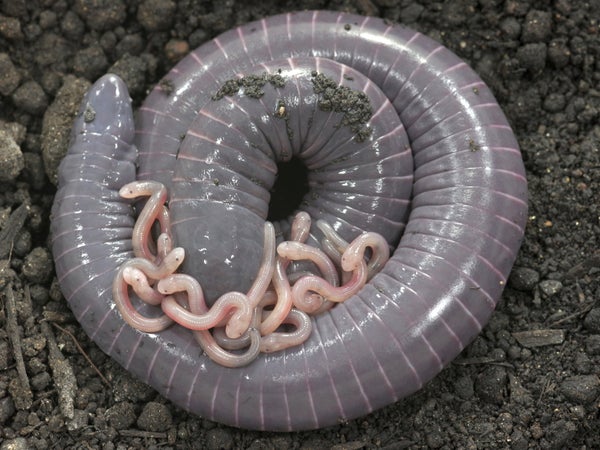The First Amphibian Known to Beg Its Mother for Milk Is More Bizarre than You Might Imagine
Surprisingly, the young of limbless amphibians called ringed caecilians stimulate their mother by touch and sound to release a milklike substance
A ringed caecilian (Siphonops annulatus) mother with newborn babies.
Caecilians are amphibians—like frogs, toads, salamanders and newts—but they look more like worms. They have no limbs and possess very rudimentary eyes, and many spend their entire life underground. This makes them very hard to study, says herpetologist Carlos Jared of the Butantan Institute in Brazil, who has spent the past 50 years getting to know them. “They are difficult to find, difficult to keep alive in the lab, difficult to breed and difficult to observe without disturbing them,” he says.
This means caecilians are still full of surprises, as Jared and his colleagues show in a new study published on Thursday in Science. Somewhat like mammals, the paper explains, females of the ringed caecilian (Siphonops annulatus) produce a milklike substance to feed their young. And remarkably the hungry hatchlings seem to actually beg their mother to release more milk—a type of behavior that has never been observed in amphibians before.
The road to this latest discovery began when a BBC team shooting footage for the series Life in Cold Blood used an endoscopic camera to film a ringed caecilian female and her offspring without disturbing them. At one point the hatchlings suddenly went into a frenzy of activity and were observed tearing off bits of their mother’s whitish outer skin layer (which only breeding females develop). This skin turned out to be full of nutritious proteins and fats, says study co-author Marta Antoniazzi of the Butantan Institute. “We were so intrigued by this that we didn’t pay much attention to the other behaviors we saw,” she says. Yet over time the researchers realized that a weekly mouthful of skin would not suffice to support the very fast growth observed in the young, which more than double in weight in their first week.
On supporting science journalism
If you’re enjoying this article, consider supporting our award-winning journalism by subscribing. By purchasing a subscription you are helping to ensure the future of impactful stories about the discoveries and ideas shaping our world today.
So the scientists returned their attention to another phenomenon the filming had revealed. “The babies’ heads were close to the female’s cloacal opening all the time,” Jared recalls. “Some even put their heads inside and seemed very excited.” Might some secretion that the pups were consuming from this opening, which is the exit for both the intestinal and urogenital systems, explain their growth spurt?
To find out, study co-author Pedro Mailho-Fontana of the Butantan Institute compared the intestines, bladders, cloacae and oviducts of females with and without offspring. This revealed some large glands in the oviducts that produce a milky substance that is rich in sugars—as well as fatty acids that also occur in humans’ and cows’ milk, such as palmitic acid and stearic acid. “They convergently evolved a similar solution” to that of mammals for feeding their young, he says.
Using a newly developed lab setup to film the nest during the entire period in which females cared for their offspring, Mailho-Fontana confirmed that the hatchlings were indeed avidly consuming the milk whenever it was released, that they competed for access to it and that they would calm down and lie on their back when satisfied.
To everyone’s further surprise, hungry young also appeared to have a way to encourage their mom to release her milk. The recordings revealed that the hatchlings weren’t just regularly touching the area around the female’s cloacal opening but were also emitting high-pitched sounds that intensified in the final minute before milk appeared. “I really did not expect anything like this,” Mailho-Fontana says, “I did not even really intend to record the sound. The camera just did it.”
“This behavior seems akin to begging in birds, which, to my knowledge, had not been documented in caecilians before,” says herpetologist Marcel Kouete of the Florida Museum of Natural History, who was not involved in the study but also works on caecilians. “This is pretty cool to learn.”
Though such begging behavior had never been observed among ringed caecilians before, they aren’t the only species of this group of animals that are known to feed a milky substance to their offspring. The behavior is quite common in caecilians that give birth to live young: such young hatch from eggs while still inside the mother’s oviduct and are fed milk there until birth. Ringed caecilians lay eggs, however, and they are the first caecilians to be found to provide milk outside the body.
Perhaps this hints at how live birth evolved in caecilians, Antoniazzi says. “Maybe caecilians started providing milk to hatchlings outside the body first, and this later enabled them to keep them inside,” she adds.
“The secretions of this egg-laying species are very, very similar to the lipid-rich secretions produced in the last few months of gestation in live bearers,” says biologist Marvalee Wake of the University of California, Berkeley, who was also not involved in this study but has worked on caecilians for many decades. She believes the behavior may likely also be found in other egg-laying species as well.
Other than caecilians, only two amphibians are known to have larvae that feed on the inner lining of the oviduct, and both of them are live bearing: the Alpine salamander (Salamandra atra) and the Nimba toad (Nimbaphrynoides occidentalis). Neither of them produce anything like milk, however.
Though milk as humans know it was an evolutionary innovation in the lineage that led to mammals, multiple other species do produce similar substances. Pigeons, flamingos and male Emperor Penguins have long been known to feed a milky substance to their young, the so-called crop milk that is produced in an expandable area of the esophagus where they normally store food. Live-bearing great white sharks also provide their pups with a nourishing milky substance as long as the young reside in their mother’s uterus. And researchers have recently reported milky baby food in jumping spiders, cockroaches and ants. Apparently, many parents across the animal kingdom have independently found that the best way to help small children grow is a squirt of milk.




